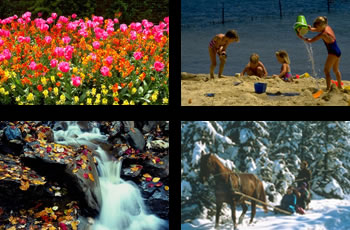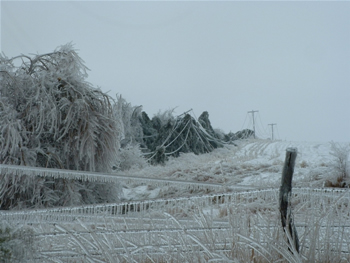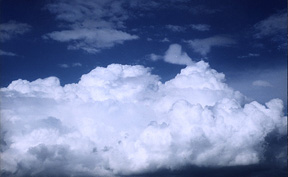This is one of the largest hailstones ever observed in the United States. The stone fell on June 22, 2003 in Aurora, Nebraska.
Click on image for full size
Courtesy of University Corporation for Atmospheric Research
Related links:
Precipitation
Hail
Hail is made in a cumulonimbus cloud where ice is tossed around by the wind. The ice crystals bump into each other and stick together making larger and larger pieces of ice. Very cold water droplets in a cloud freeze onto hailstones. When these pieces become too heavy, they fall to the ground.
Most hailstones are about the size of peas. The heaviest one in the United States was the size of a cantaloupe and fell on Kansas in 1970. Large hailstones can break windows and dent cars. A farmer’s crops can be destroyed from hail in minutes. Hail is transparent or partially opaque in color.
Hailstones do not have a perfectly round shape because the warmer temperatures below a cloud cause some of the ice to melt. Hail can fall during violent thunderstorms in the summer. Even though the summer air is warm, hail can make its way to the ground as ice without melting completely if it is large enough.
You might also be interested in:

Cumulonimbus clouds belong to the Clouds with Vertical Growth group. They are also known as thunderstorm clouds. A cumulonimbus cloud can grow up to 10km high. At this height, high winds make the top
...more
Wind is moving air. Warm air rises, and cool air comes in to take its place. This movement creates the winds around the globe. Winds move at different speeds and have different names based on their speed.
...more
Thunderstorms are one of the most exciting and dangerous types of weather. Over 40,000 thunderstorms happen around the world each day. Thunderstorms form when very warm, moist air rises into cold air.
...more
It takes the Earth one year to travel around the sun one time. During this year, there are four seasons: summer, autumn, winter, and spring. Each season depends on the amount of sunlight reaching the
...more
Sleet forms when a partially melted snowflake or raindrop turns back into ice as it is falling through the air. Sleet starts out in a cloud as a snowflake or a raindrop. It may be a snowflake or a raindrop,
...more
There are two main types of thunderstorms: ordinary and severe. Ordinary thunderstorms are the common summer storm. Ordinary thunderstorms last about one hour. Rain and small hail occur. Severe thunderstorms
...more
Below is a list of different weather advisories, watches, and warnings. Severe Thunderstorm Watch: A severe thunderstorm watch is issued when a thunderstorm with strong winds and/or hail the size of a
...more














